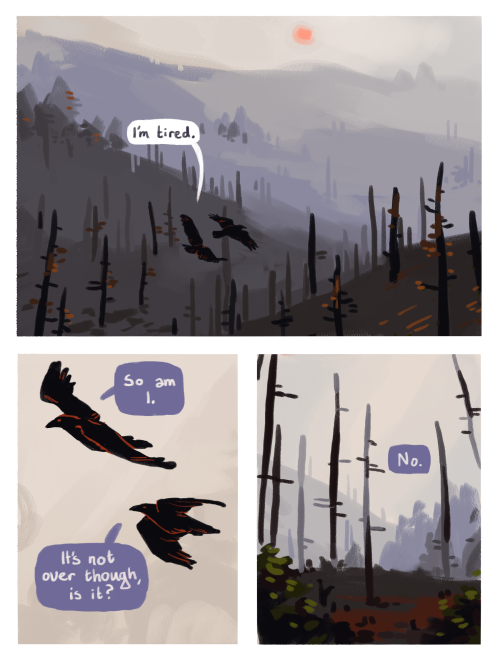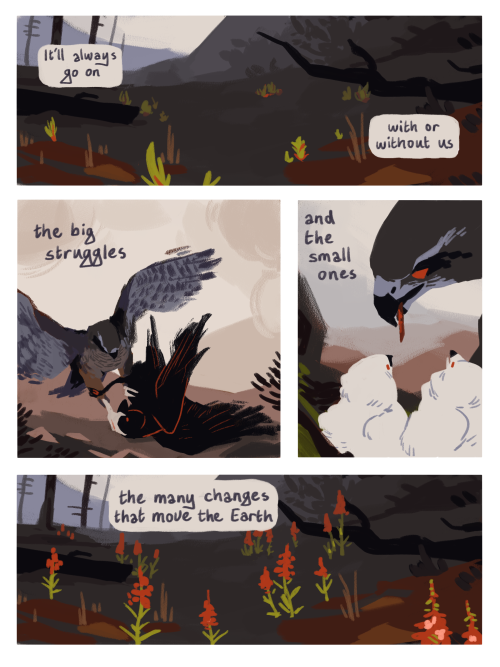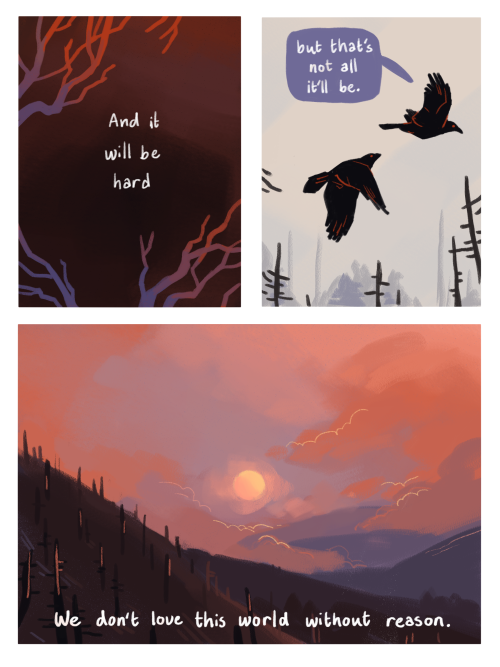Shamrockskullscarabs - Shamrocks, Skulls & Scarabs

More Posts from Shamrockskullscarabs and Others

Imagine yourself as an insect, a water beetle to be exact, swimming around searching for food when all of a sudden, a giant frog swallows you whole! What would you do then?
For Regimbartia attenuata, the only option besides accepting your fate and dissolving quietly is to search for the rear-end exit. Shinji Sugiura, an ecologist at Japan's Kobe University, discovered that these amazing beetles actively escape death by swimming through a predator's digestive tract and exiting from its butt, intact with no observable damage.
Regimbartia attenuata escaping from the vents of Pelophylax nigromaculatus and Hyla japonica (4× speed). Video credit to Current Biology
While rare, the phenomenon is not unheard of as certain snail species are known to seal their shells shut and await excretion to survive being eaten by birds or fish. However, what makes this particular research fascinating is that the prey (water beetle) is actively escaping the predator (frog) rather than passively waiting for the digestion process to be complete.

Hypothetical escape route of Regimbartia attenuata through the frog digestive system. Photo credit to Kobe University.
For further reading, you can click on the following link for the research article published in Current Biology on August 3, 2020.
Book Review: Strange and Paranormal Tales of Malacca by Dennis de Witt

Title: Strange and Paranormal Tales from Malacca
Author: Dennis de Witt
ISBN: 9789671668610
For locals and interested international readers, De Witt's compilation offers a unique insight into the type of magical fantasy and monstrous wonders that exists in Malacca and its surrounding areas. From rock-throwing poltergeists to sea monsters and even mystical old men with the power to stop vehicles from working, De Witt weaves short tales around each subject, enough to inspire awe and curiosity in the readers. The entire book is broken down into three categories:
1421 - 1824 (Malacca Malay Sultanate and the Portuguese and Dutch Colonization Era)
1825 - 1956 (British Colonization Era)
1957 - 2019 (Post-Independent Malacca and the Modern Era)
I will admit that some entries looked much too short and a question kept nagging at the back of my mind: Where's the rest?! Fortunately, as a historian, De Witt keeps a meticulous record of his findings and supplicates each entry with a list of references for further reading. Most of it is newspaper clippings but a few of them are interesting for future reads like Malay Magic by Walter Skeat and The Were-Tiger by Sir Hugh Cliffords.
Overall, this book is a good stepping stone into the world of Malay folklore, particularly Malaccan folktales. Some stories are strange, others have a dash of the paranormal, and some just make you want to find out more.
Happy Hauntings!
“Superstition is a part of the very being of humanity; and when we fancy that we are banishing it altogether, it takes refuge in the strangest nooks and corners, and then suddenly comes forth again, as soon as it believes itself at all safe.”
— Johann Wolfgang von Goethe, Maxims and Reflections
Introduction to the Six Common Types of Spirits to Expect When Going on a Spook Hunting Session
Spook-spotting requires preparations and one of the preparations needed is figuring out exactly what type of spirits we are dealing with. Depending on the case, the spook could be one of the following six:

1. The Detached or Replay Spirits. The most common spirits to encounter, replay spirits are shades of the dead that "replay" the events of their tragic deaths over and over again. They tend to keep to themselves and have minimal to zero interactions to living humans.
Protocol: Observe and record their activities without interruption. Communication may be attempted but don't get your hopes up. Even if some of them interact, there is nothing to be done for the spirit themselves. The surrounding psychic energy keeping them trapped will, according to the first law of thermodynamics, eventually dissipate, though how long they will remain trapped, only time will tell.

2. Poltergeist. German for "noisy spirit", it is the second most common spirit to encounter. Always invisible, it makes its presence known through noisy disruptions hence the name. They tend to come and go as they please, though they often focus their antics onto a particular person or family, even buildings. Though violent, it is rarely murderous.
Protocol: Be prepared with backups when dealing with these types of spirit. Chances are, your cameras and other recording equipments will be thrown about during the spook-spotting sessions. Don't forget to bring a few sets of first aid kits. There will be bruising and scratches.

3. The Interactive Spirit. Third most common spirits to encounter and the most diverse. They can range from curious benign spirits to malevolent vengeful ghosts. These are the types that have unfinished business with the living, and if encountering one, it is advisable, though not warranted, that you try to help finish their earthly business.
Protocol: Be cautious. Interactive spirits are temperamental and the slightest agitation can send them flying off the handle. Observe in groups for security, preferably 5:1 in human-to-spirit ratio. If you have a skilled negotiator, bring him or her along. These types of spirits are generally attached to a particular person or building. So if the negotiations go sideways, it is advisable to destroy said building or individual to release the spirit's bond from the earthly plane.

4. Transport or Vehicular Ghost. This is one of the rarer spirits on this list. They behave similarly to detached or replay spirits. However, it is still unknown what triggers their manisfestation. It is also uncertain whether these can be considered spirits at all.
Protocol: Observe and record as normal. Corporeality of vehicular spirits have not been tested since these spirits usually appear far away from observers. For vehicular spirits that appear close to the observer, take caution as people approached by said spirits often report feeling anxious and unexplained dread when approached by these apparitions

5. Animal spirits. About as rare as vehicular spirits, cases of actual animal spirits are still quite uncommon because often witnesses confuse seeing animal spirits with demon cats or hellhounds. They often haunt their previous owners and can be either benign or malicious, depending on how their owners treat them when they are still alive
Protocol: Be nice. These spirits still have an attachment to their owners and it's best not to provoke either them or their owners. Keep your documenting equipment on standby as most cases involving animal spirits only document quick animal-like motions or mannerisms only their owners recognize. Full body apparitions are rare.

6. The Omen Spirit. Rarest of the six spooks and the hardest to document. They typically appear to a particular person or group and they never stay long. Sightings range from pale shades to full-body apparitions.
Protocol: Be vigilant and keep your documenting equipment on standby all the time. You'll have a better chance to capture it on camera if the spirit is attached to a group rather than a person.
These are the Big Six though there are variations within each of them. Some may argue that since vehicular spirits behaved very similarly to detached spirits, these two should be within a supergroup of their own. But whatever your arguments may be regarding spirit classification, always keep your wits about and have a safe spook spotting session wherever you might be.
Happy Hauntings!
Pengabdi Setan (2017)

Pengabdi Setan, also known as Satan's Slave, is an Indonesian horror movie written and directed by Joko Anwar who also worked on other Indonesian horror films such as Perempuan Tanah Jahanam (Woman of the Damned Land aka Impetigore, 2019) and Ratu Ilmu Hitam (The Queen of Black Magic, 2019).

In the film, the matriarch who fell ill more than 3 years ago passed away under mysterious circumstances, setting a chain of horrific motions haunting her children Rini (Tara Basro), Tony (Endy Arfian), Bondi (Nasar Anuz), and Ian (Muhammad Adhiyat). Set in the early 1980s, Joko Anwar sets the mood with dim lighting and plot twists, evoking a building sense of suspense that climaxes into a horrific peak involving fertility cults and zombified pocongs.

Aside from the riveting storyline and awesome cast and crew, one thing that stuck with me is the soundtrack. Throughout the entire movie, snippets of Kelam Malam, performed by The Spouse and introduced as the matriarch's hit song early in the film, further set the mood playing throughout the movie with its haunting melody and suggestive lyrics.

The easter egg ending features Darminah who, for those who don't know, appeared in the 1980 version of Pengabdi Setan making this movie a remake, though some suggest it is also a prequel given that the 2017 setting was 1981 while the 1980 setting was 1982. Regardless, the seductive ending scene set against Diwajahmu Kulihat Bulan by Sam Saimun also set the mood for the sequel which we will see soon this year in 2022.
Happy Hauntings!

If you love the multitude of horrors found at the SCP wiki, you'll enjoy this short horror comic by Azam Raharjo, inspired by our resident strangler, SCP-173 him/her/itself (??). You can check the comic out and his other works here. His Twitter link is also available here for a follow.
A part of being an adult is living with regret and not allowing it to consume you. The older you get, the more mistakes you’ve made, opportunities you’ve missed, people you’ve disappointed. And every day you have to remind yourself to be kind and forgiving of yourself. You accept and love the you from the past and understand that it’s all a part of the process. Then you move on and live your best life, knowing now as old as you feel today, you’ll never be this young again.
Ready to pounce an unseen victim or victims, the tiger draws our attention to it first before our minds wander to the raging storm and billowing vegetation in the background and foreground. It is an inspirational, haunting piece on the powers of desperation or determination, where our subject drags us in its devotion to the point of ignoring everything else that's happening elsewhere.
Perhaps that was the mind-state that Henri Rousseau was experiencing at the time of the painting's creation. A late bloomer in the art scene, he could have been desperate or determined enough to make a breakthrough into the art world. And that desperation or determination is poured into the painting where despite the dangers of the raging storm, our tiger is either very desperate or very hungry for food. Either way, it is a very dangerous mix to have that state of mind.
Perhaps, it was a good thing that his artwork was accepted at the Salon des Independants. Wonder what would have happened if the painting was rejected again, in that state of his?

Henri Rousseau, Tiger in a Tropical Storm, 1891.
-
 achronalart reblogged this · 5 days ago
achronalart reblogged this · 5 days ago -
 achronalart liked this · 5 days ago
achronalart liked this · 5 days ago -
 the-rambling-dragon reblogged this · 6 days ago
the-rambling-dragon reblogged this · 6 days ago -
 eclipsesoddobsessionwithslugs liked this · 1 week ago
eclipsesoddobsessionwithslugs liked this · 1 week ago -
 elbuenjardinero liked this · 1 week ago
elbuenjardinero liked this · 1 week ago -
 gloweyeyesgobrrrrrrr reblogged this · 1 week ago
gloweyeyesgobrrrrrrr reblogged this · 1 week ago -
 corrosive-cyanide reblogged this · 1 week ago
corrosive-cyanide reblogged this · 1 week ago -
 corrosive-cyanide liked this · 1 week ago
corrosive-cyanide liked this · 1 week ago -
 wickedest-of-roses reblogged this · 1 week ago
wickedest-of-roses reblogged this · 1 week ago -
 wickedest-of-roses liked this · 1 week ago
wickedest-of-roses liked this · 1 week ago -
 lessproblematical reblogged this · 1 week ago
lessproblematical reblogged this · 1 week ago -
 lessproblematical liked this · 1 week ago
lessproblematical liked this · 1 week ago -
 tigerliliesandcherryblossoms liked this · 1 week ago
tigerliliesandcherryblossoms liked this · 1 week ago -
 spreadsheetlesbian liked this · 1 week ago
spreadsheetlesbian liked this · 1 week ago -
 thehelpermouse reblogged this · 1 week ago
thehelpermouse reblogged this · 1 week ago -
 herrlichersonnigertag liked this · 1 week ago
herrlichersonnigertag liked this · 1 week ago -
 patcheypat reblogged this · 1 week ago
patcheypat reblogged this · 1 week ago -
 oi-dancing-boy liked this · 1 week ago
oi-dancing-boy liked this · 1 week ago -
 lazyursa reblogged this · 1 week ago
lazyursa reblogged this · 1 week ago -
 lazyursa liked this · 1 week ago
lazyursa liked this · 1 week ago -
 captainalexasaurus liked this · 1 week ago
captainalexasaurus liked this · 1 week ago -
 doctorwormandtheelectricmayhem reblogged this · 1 week ago
doctorwormandtheelectricmayhem reblogged this · 1 week ago -
 nevereatpearss reblogged this · 1 week ago
nevereatpearss reblogged this · 1 week ago -
 misty-re liked this · 1 week ago
misty-re liked this · 1 week ago -
 mainlysarcastic reblogged this · 1 week ago
mainlysarcastic reblogged this · 1 week ago -
 dnl-75 liked this · 1 week ago
dnl-75 liked this · 1 week ago -
 undead-r3d reblogged this · 1 week ago
undead-r3d reblogged this · 1 week ago -
 acompilationofcats reblogged this · 1 week ago
acompilationofcats reblogged this · 1 week ago -
 popcornfairy28 liked this · 1 week ago
popcornfairy28 liked this · 1 week ago -
 diamondstripe1 liked this · 1 week ago
diamondstripe1 liked this · 1 week ago -
 formlesschromatic reblogged this · 1 week ago
formlesschromatic reblogged this · 1 week ago -
 formlesschromatic liked this · 1 week ago
formlesschromatic liked this · 1 week ago -
 radioactivefish reblogged this · 1 week ago
radioactivefish reblogged this · 1 week ago -
 noxxygizmo reblogged this · 1 week ago
noxxygizmo reblogged this · 1 week ago -
 noxxygizmo liked this · 1 week ago
noxxygizmo liked this · 1 week ago -
 souperdupes liked this · 1 week ago
souperdupes liked this · 1 week ago -
 brumastequio liked this · 1 week ago
brumastequio liked this · 1 week ago -
 water-bearing-bitch liked this · 1 week ago
water-bearing-bitch liked this · 1 week ago -
 nativehero69 reblogged this · 1 week ago
nativehero69 reblogged this · 1 week ago -
 nativehero69 liked this · 1 week ago
nativehero69 liked this · 1 week ago -
 yeetb01 liked this · 1 week ago
yeetb01 liked this · 1 week ago -
 tiredwlw reblogged this · 1 week ago
tiredwlw reblogged this · 1 week ago -
 t4t4ever liked this · 1 week ago
t4t4ever liked this · 1 week ago -
 nongendered reblogged this · 1 week ago
nongendered reblogged this · 1 week ago -
 athenakeene liked this · 1 week ago
athenakeene liked this · 1 week ago -
 helloperson90 liked this · 1 week ago
helloperson90 liked this · 1 week ago -
 piscesprophecies liked this · 1 week ago
piscesprophecies liked this · 1 week ago -
 whattheforck reblogged this · 1 week ago
whattheforck reblogged this · 1 week ago -
 dollydollspookprincess reblogged this · 1 week ago
dollydollspookprincess reblogged this · 1 week ago

55 posts




